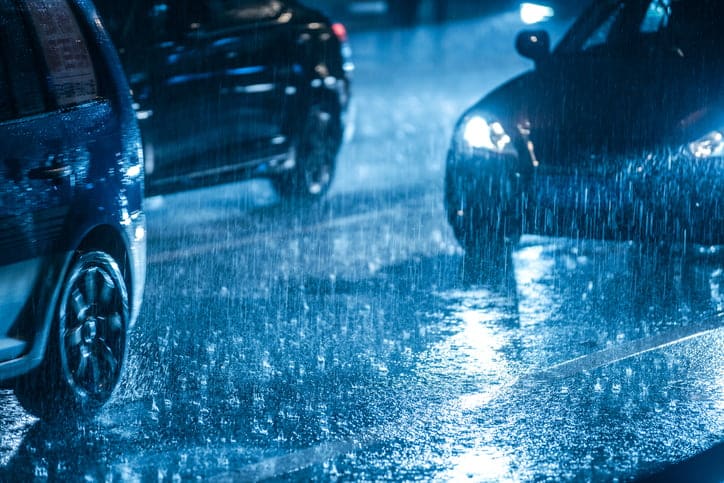Whether you have driven through a deep puddle, accidentally left your windows open or there’s a problem with one of the door seals; water can cause serious damage to your car, affecting its mechanics as well as how it looks. Even if the interior has got damp in a downpour, it could leave you with stains and fusty odours which may impact your car’s value.
In this guide, we’ll show you what to do when your car has flooded in the rain, including common mechanical faults, cleaning after flooding, and problem areas where sealant leaks are likely to occur. We’ll also answer common questions relating to things like insurance cover, as well as the symptoms of flood damage.
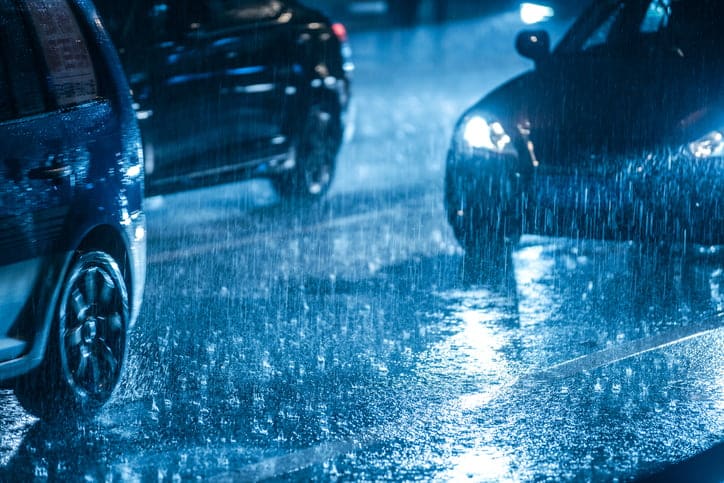
Quick Links:
- Flooded Car Symptoms: How to Know your Car has Flood Damage
- Mechanical Faults Caused by Flooding
- What to Do Immediately After Finding Out Your Car Has Flooded
- Common Areas Where Cars Can Develop Rain Leaks
- Does my Car Insurance Cover Flood Damage?
- How to Clean & Dry a Water-Damaged Car
Flooded Car Symptoms: How to Know your Car has Flood Damage
Although you should make every effort to avoid driving through floods and water, it can be unavoidable in certain situations. As such, it’s important to know the symptoms that can tell you when your car has been damaged by flood waters, which include:
- Faulty electrics – noticed that some electrical components in your car are no longing functioning properly after driving through water? They could have been exposed to water which has damaged the circuitry or caused a short. Components to check extend from everything to the lights and wipers to the windows and infotainment system.
- Non-starting engine – if your engine no longer turns over and fires after driving through a flood, you could have a big problem on your hands. From hydrolock (more on this below) to battery issues, water can wreak havoc on the starter process, and such faults may be expensive to put right.
- Damp carpets and excess moisture in the cabin – water ingress in the cabin can occur during and after driving through flood water, with moisture able to get in through the floor and the door seals. It’s important to dry the cabin thoroughly in this instance, since mould and mildew could cause more prolonged issues later down the line.
Mechanical Faults Caused by Flooding
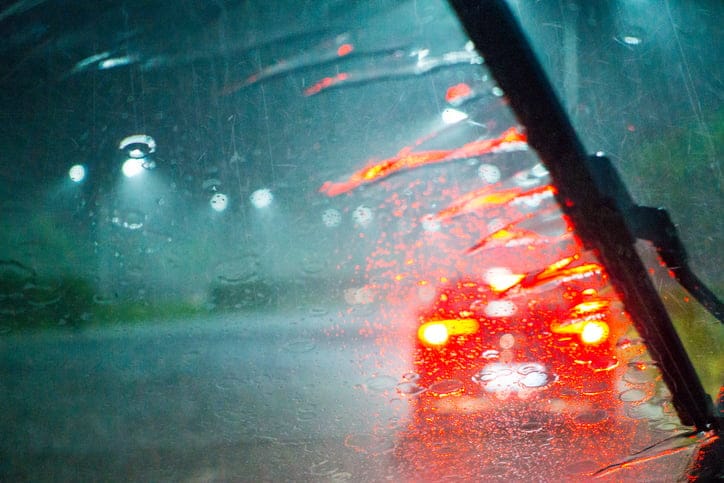
If your car has been flooded by rain, there are lots of things that can go wrong with its mechanics – both under the bonnet and in the cabin. We’ve listed some of these common faults and problems below:
- Hydrolock – As above, hydrolock is the worst-case scenario for your car. It normally happens when water has got into the air intake and been sucked into the engine, where it damages the pistons and combustion cycle. Remember – don’t attempt to start your car if you think water could get into the engine.
- Electrical problems – Electrical problems can occur in the cabin if water has got in after a downpour. Some of the most common faults affect the wiring, radio, computers, dashboard and electric windows. If you think water has got into the car, don’t fiddle with any electrics until you’re confident it’s dry, as you risk an electric shock.
- Rusting – Rust is the obvious thing to look out for when your car has been flooded by heavy rain, and it can affect all exposed metalwork, including on the undercarriage, in the bonnet and in the boot. Check all metal surfaces regularly after a flood for the early onset of rust, and always take steps to dry the car as thoroughly as you can.
- Mechanical problems with moving parts – From the brake and clutch assemblies to the starter, water can cause problems for different moving parts on your car. Have your car thoroughly checked over by a professional after flooding to make sure everything is working as it should.
What to Do Immediately After Finding Out Your Car Has Flooded
If you return to your car to find water in the cabin or a non-starting engine, there a few things you need to do to prevent serious damage:
- Do not try to start the car again – If water gets into the engine, transmission or fuel system, it’ll only make the problem worse. Water can destroy internal engine parts and cause ‘hydrolock’, when the pistons fail to compress and move as they should. If hydrolock occurs, you’re looking at huge repair bills or the prospect of getting a new car.
- Start removing water – The less time water is left to stand in your car’s interior, the less chance it has of causing damage and getting into mechanical components where it can cause more damage. If your car literally has puddles in it, you’ll need a wet/dry vacuum cleaner to get rid of them (don’t try using your standard vacuum, as you could get an electric shock).
- Get air into the car – A good flow of air is essential to dry out a wet car, and will help prevent mould, mildew and bad odours. Park your car somewhere covered, open all the windows, and use an electric fan to get the air moving, pointing it at the affected area if possible.
- If this isn’t possible but you need to get the interior dry, switching on the engine and running the fan heaters is another way of speeding up the drying process. Just make sure you check the condition of your engine (preferably with a professional) before switching it on, to prevent hydrolock.
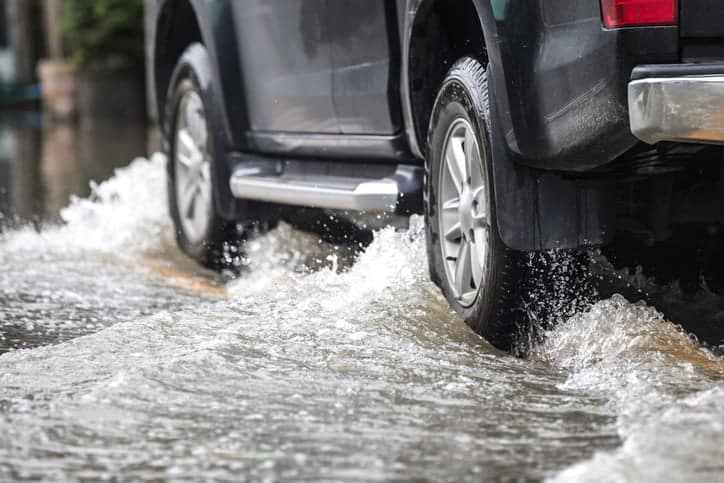
Common Areas Where Cars Can Develop Rain Leaks
No matter how old or well-maintained your car is, a faulty window or door seal can let rain into the cabin and boot, and that’s not good. Even if it’s just a few drips every now and again, a leaky door seal could lead to a bigger problem, especially if water gets into upholstery or electrical components.
Leaks generally occur when the weather stripping along the side of doors and windows is worn or damaged, letting air and moisture into the car. This can happen anywhere weather stripping is in place, but is especially common where the strip is placed horizontally – meaning that water doesn’t drain away as quickly.
The best way to prevent weather stripping from wearing and becoming brittle is to clean and maintain it like any other part of your car. We’d recommend carefully cleaning weather stripping with standard car shampoo, before treating it regularly with a silicone-based conditioning spray.
Does my Car Insurance Cover Flood Damage?
Wondering whether or not your insurance covers you against flood damage?
If you have fully comprehensive car insurance, you should be able to make a claim. However, it all depends on the wording of your policy, so read the Ts and Cs carefully before approaching your insurer.
If you only have third party or third party fire and theft car insurance, it’s unlikely that you’ll be able to make a claim. So, consider this carefully when choosing your next policy, particularly if you live in an area that’s prone to a high volume of rainfall.
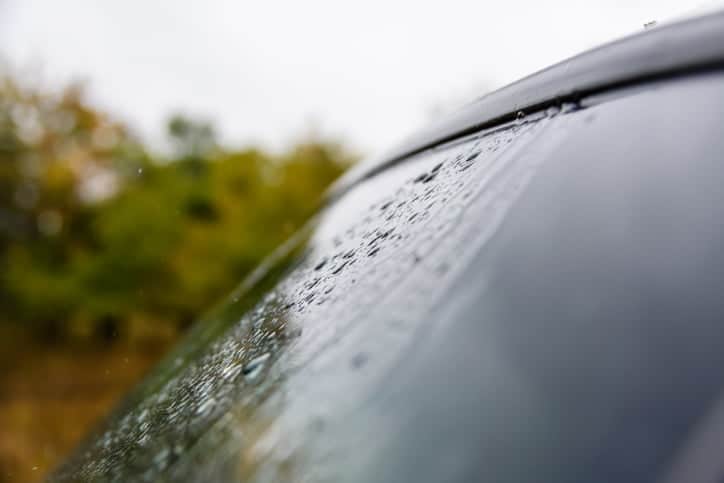
Regardless of the type of insurance policy you have, you’ll only be able to claim for damages if your insurer deems it was unavoidable. For example, if your car was damaged in flood water where it’s usually parked (say, on your drive), you should be able to claim for the full amount against your premium.
If, however, you chose to drive through a flood, your insurer will want to know why you made this decision. If they deem that the damage was avoidable, you may not be covered.
After contacting your insurer, they’ll assess your car to calculate the total damage. This is to ascertain whether the damage is repairable or if the car needs to be written off.
Currently, there are six ‘repair status’ categories which insurers use to assess vehicular damage. These are:
- A – Unrepairable
- B – Unrepairable
- C – Repair would cost more than vehicle value
- D – Total repair and transport cost would be more than vehicle value
- N – Repairable, with non-structural damage
- S – Repairable, with structural damage
If your car falls into any of the first four categories due to flood damage, it’s likely to be written off by your insurer.
How to Clean & Dry a Water-Damaged Car
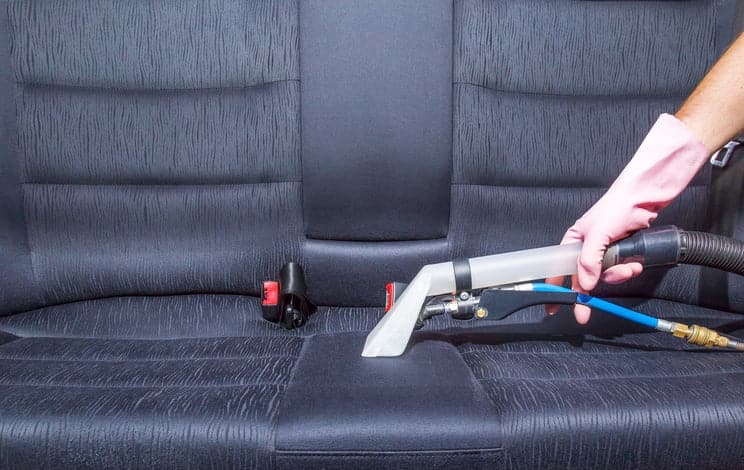
Cleaning and drying a flooded car can be a difficult and time-consuming process, because water can travel a surprisingly long way from the point where it first leaked into your car. If the water has gotten into upholstery like the seats and carpets, it’s even trickier to clean, and may take several days before you can get it completely clean and dry.
Follow these steps to clean the inside of a flooded car:
- Use a wet/dry vacuum to remove as much water as you can from the interior. If you can’t get hold of one, use kitchen towel (and lots of it) to absorb the water from the upholstery, carpets and seats. Standard household towels work well too.
- When you’re confident you’ve got as much water out as possible, open the windows and allow it to dry – preferably somewhere covered. Alternatively, turn on the heating and put the fans on full to begin to dry out the car from the inside.
- Next, give the car a thorough clean using an upholstery cleaner. Pick one which has a brush built in so you can clean and scrub at the same time, perfect for dealing with unsightly water marks and odours.
- Over the next few days, keep an eye on your car and make sure there are no damp odours or moisture, which could be a sign that there’s still a leak or you’ve missed some of the water. It’s important to deal with any water properly, as over time it could cause rusting, mould or bad odours.
At Holts, we’re here to help you take better care of your car with our range of brilliant DIY car care and maintenance products. For more information, visit our homepage today.
